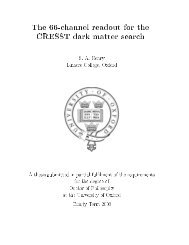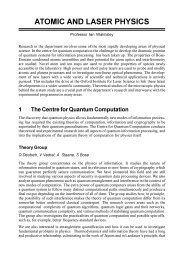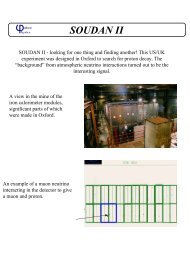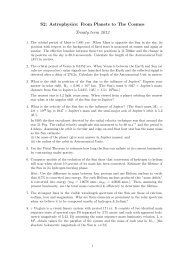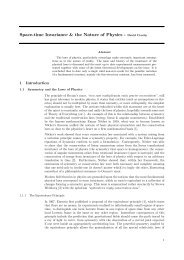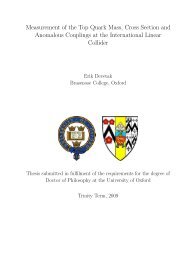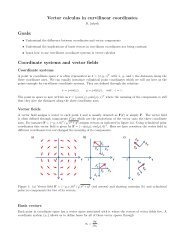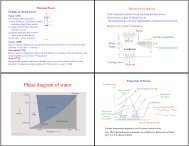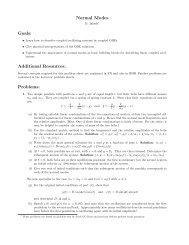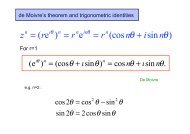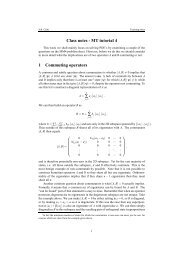vmiii
vmiii
vmiii
You also want an ePaper? Increase the reach of your titles
YUMPU automatically turns print PDFs into web optimized ePapers that Google loves.
Vectors and Matrices Problems<br />
Prof Neville Harnew, MT2008<br />
Problem Set 3: Matrices Part I<br />
1. Simple introduction to some properties of matrices. Evaluate/show the following:<br />
a) If<br />
(<br />
1 2 3<br />
A =<br />
−1 0 2<br />
find A + B and 2A − 3B.<br />
)<br />
and B =<br />
(<br />
−1 5 −2<br />
2 2 −1<br />
b) In general, matrices are non-commutative (AB ≠ BA). Demonstrate this for<br />
( ) ( )<br />
1 2<br />
2 0<br />
A =<br />
, B = .<br />
3 −1<br />
1 1<br />
)<br />
,<br />
c) However, show that a matrix of the form<br />
(<br />
a −b<br />
A =<br />
−b a<br />
)<br />
does have a commutative product.<br />
d) Matric multiplication is associative, i.e. (AB)C = A(BC). Show this for<br />
⎛ ⎞<br />
( ) 1 1 ( )<br />
2 1 −1 ⎜ ⎟ 1<br />
A =<br />
,B = ⎝ 2 0 ⎠ ,C = .<br />
3 1 2<br />
3<br />
3 −1<br />
e) If A is the matrix<br />
A =<br />
⎛<br />
⎜<br />
⎝<br />
1 1 1<br />
0 1 1<br />
0 0 1<br />
calculate A 2 and A 3 .<br />
f) If A, B are square n × n matrices, then the traces of the products are given by<br />
Tr{AB} =Tr{BA}. Show this for<br />
⎛<br />
⎞ ⎛<br />
⎞<br />
1 −1 1<br />
3 1 2<br />
⎜<br />
⎟ ⎜<br />
⎟<br />
A = ⎝ 2 4 1 ⎠ , B = ⎝ 1 1 0 ⎠ .<br />
3 0 1<br />
−1 2 1<br />
g) If A, B are arbitrary m × n matrices, show that (A + B) T = A T + B T ,whereT<br />
represents the transpose.<br />
⎞<br />
⎟<br />
⎠<br />
1
2. Find the inverse of A.B with<br />
( )<br />
−3 −5<br />
A =<br />
, B =<br />
5 9<br />
(<br />
5 3<br />
3 2<br />
)<br />
.<br />
3. Find the two-dimensional matrix A which has the properties:<br />
( (<br />
1 1<br />
A =<br />
0)<br />
1)<br />
and<br />
A −1 (<br />
1<br />
2<br />
)<br />
=<br />
( )<br />
1<br />
.<br />
−1<br />
4. For which values of α is the matrix<br />
⎛<br />
A =<br />
⎜<br />
⎝<br />
not invertible (i.e. the inverse doesn’t exist)?<br />
1 −3 2<br />
−α −1 2<br />
3 α −4<br />
⎞<br />
⎟<br />
⎠<br />
5. Find a general 2 × 2matrixA such that<br />
( )<br />
A 2 −1 0<br />
= −I =<br />
.<br />
0 −1<br />
What are the elements of A if the matrix is diagonal?<br />
6. Let A be a square matrix<br />
a) If A 2 =0showthatI − A is invertible.<br />
b) If A 3 =0showthatI − A is invertible.<br />
c) If A n = 0 for some positive integer n, show that I − A is invertible.<br />
d) If A 2 +2A + I = 0, show that A is invertible.<br />
7. Calculate the determinants of the matrices<br />
⎛<br />
⎞<br />
⎛<br />
0 −i i<br />
⎜<br />
⎟<br />
(a) A = ⎝ i 0 −i ⎠ , (b) B = 1 ⎜<br />
√ ⎝ 8<br />
−i i 0<br />
√ √ √ ⎞<br />
3 − 2 − 3<br />
√<br />
1 6 −1<br />
2 0 2<br />
⎟<br />
⎠ .<br />
Are the matrices (i) real, (ii) diagonal, (iii) symmetric, (iv) antisymmetric, (v) singular,<br />
(vi) orthogonal, (vii) Hermitian, (viii) anti-Hermitian, (ix) unitary, (x) normal?<br />
2
8. A vector y is related to vector x by the equation<br />
y = Kx<br />
where K is a matrix. ⎛ For ⎞ the case when ⎛ x and ⎞ y are ⎛both⎞3−dimensional ⎛ vectors, ⎞ it<br />
1<br />
1<br />
0<br />
0<br />
⎜ ⎟<br />
⎜ ⎟ ⎜ ⎟<br />
⎜ ⎟<br />
is found that y = ⎝ 0 ⎠ when x = ⎝ 2 ⎠, y = ⎝ 1 ⎠ when x = ⎝ 1 ⎠, and<br />
0<br />
−2<br />
0<br />
3<br />
y =<br />
⎛<br />
⎜<br />
⎝<br />
0<br />
0<br />
1<br />
⎞<br />
⎟<br />
⎠ when x =<br />
⎛<br />
⎜<br />
⎝<br />
1<br />
−2<br />
−5<br />
⎞<br />
⎟<br />
⎠.<br />
Write down the inverse matrix K −1 and then calculate the matrix K.<br />
9. A is a non-singular 3×3matrixandB =2A −1 .CalculateTr{AB} and det(A)det(B).<br />
10. Demonstrate that the determinant of a 3 × 3 matrix does not change if one of<br />
the matrix rows is multiplied by a constant k and added to another row so that the<br />
new matrix has two rows unchanged and one row replaced with the new elements. This<br />
property is important in the solution of systems of linear equations.<br />
11. Prove the following results involving Hermitian matrices:<br />
a) If A is Hermitian and U is unitary then U −1 AU is Hermitian.<br />
b) If A is anti-Hermitian then iA is Hermitian.<br />
c) The product of two Hermitian matrices A and B is Hermitian if and only if A and<br />
B commute.<br />
12. The points A =<br />
(<br />
x<br />
y<br />
)<br />
and A ′ =<br />
(<br />
x<br />
′<br />
y ′ )<br />
are related by the equation<br />
A ′ = RA<br />
( )<br />
cos θ sin θ<br />
where R is the (2 × 2) matrix, R =<br />
. By expressing x<br />
− sin θ cos θ<br />
2 + y 2 and<br />
x ′2 + y ′2 in terms of A and A ′ respectively show that x 2 + y 2 = x ′2 + y ′2 and hence find<br />
the inverse, R −1 , of R.<br />
13. A linear homogeneous transformation that moves a point r =(x, y, z) toanew<br />
point r ′ =(x ′ ,y ′ ,z ′ ) can be represented by a matrix M such that Mr = r ′ . Determine<br />
the 3 × 3 matrices for the following situations:<br />
(a) A counter-clockwise rotation by an angle α about the z-axis.<br />
(b) A counter-clockwise rotation by an angle β about the x-axis.<br />
(c) Counter-clockwise rotations, first by an angle β about the x-axis and then by an<br />
angle α about the z-axis.<br />
3




